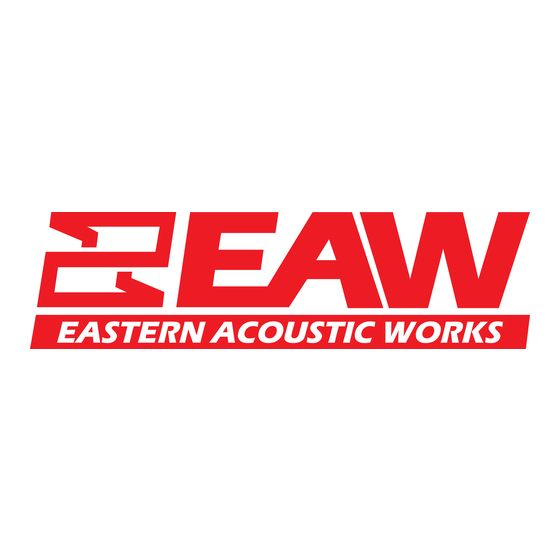
Advertisement
Quick Links
ASG Tech Note: Connecting and Communicating with DSA:
This technical note is intended to help connect and communicate with the DSA loudspeaker. In
general, the process for connecting and operating a DSA loudspeaker should be as follows:
1. Read the manual.
2. Download the latest version of the DSA Pilot software from the EAW Website
(http://www.eaw.com/downloads/).
3. If your computer has an on-board RS-232 serial port, use a B&B Electronics
RS232 - 485, half-duplex, port-powered converter to connect between your computer and
the DSA.
4. If your computer does not have an on-board RS-232 serial port, use the recommended
B&B Electronics USB-to-RS485 converter (available for purchase directly from EAW).
5. Once physically connected, launch DSA Pilot and select the appropriate communications
port. Go 'Online', add your clusters and assign your DSA modules.
6. EQ and Steer the DSA Cluster(s) as necessary.
1. Please read the manual:
http://www.eaw.com/docs/1_Current_Products/DSA
In the manual, you will find all the specifics of DSA, including: how it works, how to connect with
DSA, how to wire the DSA, all the available features, and some nifty tricks. A thorough review of
the manual will provide you with a comprehensive overview of the DSA and how it functions. If
you have questions, please call ASG @ 1-800-992-5013 before you connect with the DSA.
2. Download the latest version of our DSA Pilot software:
http://www.eaw.com/downloads
The latest version is always available on the EAW website. After you download the .zip file from
the website, extract it to your desktop and run the installer. Let the program to its default location
on your hard drive; do not change directories.
The installation process will put a short cut icon on your desktop.
to launch DSA Pilot. EAW suggests checking the website periodically for updated versions of
DSA Pilot, especially prior to connecting to a DSA.
Note:
You can work offline within DSA Pilot. This is helpful to see how DSA will work for coverage of an
area. By entering information in the respective fields and clicking on 'Apply', you will see how a
DSA cluster will work in a given space by referencing the SPL chart at the bottom of the window.
Double-click on this icon
Advertisement

Subscribe to Our Youtube Channel
Summary of Contents for EAW DSA
- Page 1 DSA Pilot, especially prior to connecting to a DSA. Note: You can work offline within DSA Pilot. This is helpful to see how DSA will work for coverage of an area. By entering information in the respective fields and clicking on ‘Apply’, you will see how a...
- Page 2 You may purchase these converters directly from B&B Electronics on their website: (http://www.bb-elec.com/product_family.asp?FamilyId=15&TrailType=Sub&Trail=12) Note: If you are able to connect and program the DSA using any other brand of converter, please contact us asg@eaw.com so we may add it to the list.
- Page 3 DSA RS-485 Ground Ground On the DSA, ensure that the “EIA-485 Terminate” switch is in the “On” position for the last DSA in the RS-485 chain (farthest from the computer). If only one DSA is connected to the computer, this switch should be in the “On”...
-
Page 4: Troubleshooting
Step 1: Get the proper 232 serial connection from your computer. See Section 3 above. Step 2: Reconnect to DSA. Step 3: Go online (see Section 6 below) – this should call up the DSA module you were upgrading firmware. - Page 5 ‘Modules’ when not assigned to a cluster. Clicking on an individual DSA module will light up its respective LED on the front. It is here you can right click on the individual DSA module and run diagnostics, as well as rename the individual DSA module and upgrade firmware.
- Page 6 Note: All currently available clusters are in this drop down menu. This menu supersedes the printed DSA Manual. Note the position of LED’s in the pictures of clusters. This is helpful in making sure that the DSA modules within the cluster(s) you install on the wall are in fact in the correct orientation.
- Page 7 DSA modules to its respective cluster. This is done by left clicking the individual DSA module so it grays out, clicking the ‘ASSIGN’ button (the button will light up, a stylus will now appear where your cursor/arrow was), then left clicking on the respective DSA module under the cluster you wish to assign that module to.
- Page 8 READ SETTINGS FROM THE LOUDSPEAKER: If you are connecting to an existing installed DSA module, need to see how a DSA is set up, or any application where you do not wish to erase the steering and EQ settings of your DSA, click this.
- Page 9 Once connected, you can EQ and Steer your DSA cluster. It is important to realize that individual DSA modules are never steered or EQ’d – only clusters are steered and EQ’d. You can get to the steering and EQ windows either through the “Tools” drop down menu, or by right-clicking once on the cluster you wish to steer or EQ.
- Page 10 ‘skim’ the heads of the listening audience, such that the most distant seats are on-axis, with nearer seats becoming progressively more off-axis as you approach the column. This limitation does not apply to DSA, which can form complex beams that are not centered on the vertical axis of the loudspeaker.





Need help?
Do you have a question about the DSA and is the answer not in the manual?
Questions and answers